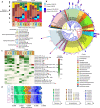Future climate conditions accelerate wheat straw decomposition alongside altered microbial community composition, assembly patterns, and interaction networks
- PMID: 36352255
- PMCID: PMC9860053
- DOI: 10.1038/s41396-022-01336-2
Future climate conditions accelerate wheat straw decomposition alongside altered microbial community composition, assembly patterns, and interaction networks
Abstract
Although microbial decomposition of plant litter plays a crucial role in nutrient cycling and soil fertility, we know less about likely links of specific microbial traits and decomposition, especially in relation to climate change. We study here wheat straw decomposition under ambient and manipulated conditions simulating a future climate scenario (next 80 years) in agroecosystems, including decay rates, macronutrient dynamics, enzyme activity, and microbial communities. We show that future climate will accelerate straw decay rates only during the early phase of the decomposition process. Additionally, the projected climate change will increase the relative abundance of saprotrophic fungi in decomposing wheat straw. Moreover, the impact of future climate on microbial community assembly and molecular ecological networks of both bacteria and fungi will strongly depend on the decomposition phase. During the early phase of straw decomposition, stochastic processes dominated microbial assembly under ambient climate conditions, whereas deterministic processes highly dominated bacterial and fungal communities under simulated future climate conditions. In the later decomposition phase, similar assembly processes shaped the microbial communities under both climate scenarios. Furthermore, over the early phases of decomposition, simulated future climate enhanced the complexity of microbial interaction networks. We concluded that the impact of future climate on straw decay rate and associated microbial traits like assembly processes and inter-community interactions is restricted to the early phase of decomposition.
© 2022. The Author(s).
Conflict of interest statement
The authors declare no competing interests.
Figures






Similar articles
-
Life in the Wheat Litter: Effects of Future Climate on Microbiome and Function During the Early Phase of Decomposition.Microb Ecol. 2022 Jul;84(1):90-105. doi: 10.1007/s00248-021-01840-6. Epub 2021 Sep 6. Microb Ecol. 2022. PMID: 34487212 Free PMC article.
-
Climate warming enhances microbial network complexity by increasing bacterial diversity and fungal interaction strength in litter decomposition.Sci Total Environ. 2024 Jan 15;908:168444. doi: 10.1016/j.scitotenv.2023.168444. Epub 2023 Nov 8. Sci Total Environ. 2024. PMID: 37949122
-
Future climate change enhances the complexity of plastisphere microbial co-occurrence networks, but does not significantly affect the community assembly.Sci Total Environ. 2022 Oct 20;844:157016. doi: 10.1016/j.scitotenv.2022.157016. Epub 2022 Jun 28. Sci Total Environ. 2022. PMID: 35777560
-
Decoupling the direct and indirect effects of climate on plant litter decomposition: Accounting for stress-induced modifications in plant chemistry.Glob Chang Biol. 2018 Apr;24(4):1428-1451. doi: 10.1111/gcb.13923. Epub 2018 Jan 28. Glob Chang Biol. 2018. PMID: 28986956 Review.
-
Agricultural soil microbiomes at the climate frontier: Nutrient-mediated adaptation strategies for sustainable farming.Ecotoxicol Environ Saf. 2025 Apr 15;295:118161. doi: 10.1016/j.ecoenv.2025.118161. Epub 2025 Apr 8. Ecotoxicol Environ Saf. 2025. PMID: 40203703 Review.
Cited by
-
Composition, interaction networks, and nitrogen metabolism patterns of bacterioplankton communities in a grassland type Lake: a case of Hulun Lake, China.Front Microbiol. 2023 Nov 22;14:1305345. doi: 10.3389/fmicb.2023.1305345. eCollection 2023. Front Microbiol. 2023. PMID: 38075882 Free PMC article.
-
Impact of straw returning on soil ecology and crop yield: A review.Heliyon. 2025 Jan 3;11(2):e41651. doi: 10.1016/j.heliyon.2025.e41651. eCollection 2025 Jan 30. Heliyon. 2025. PMID: 39882467 Free PMC article. Review.
-
Impact of conservation tillage on wheat performance and its microbiome.Front Plant Sci. 2023 Aug 21;14:1211758. doi: 10.3389/fpls.2023.1211758. eCollection 2023. Front Plant Sci. 2023. PMID: 37670872 Free PMC article.
-
Impacts of long-term different fertilization regimes on microbial utilization of straw-derived carbon in greenhouse vegetable soils: insights from its ecophysiological roles and temperature responses.Front Plant Sci. 2024 Oct 25;15:1486817. doi: 10.3389/fpls.2024.1486817. eCollection 2024. Front Plant Sci. 2024. PMID: 39524564 Free PMC article.
-
Microbial Community Colonization Process Unveiled through eDNA-PFU Technology in Mesocosm Ecosystems.Microorganisms. 2023 Oct 5;11(10):2498. doi: 10.3390/microorganisms11102498. Microorganisms. 2023. PMID: 37894156 Free PMC article.
References
-
- Grimm NB, Chapin FS, Bierwagen B, Gonzalez P, Groffman PM, Luo Y, et al. The impacts of climate change on ecosystem structure and function. Front Ecol Environ. 2013;11:474–82. doi: 10.1890/120282. - DOI
-
- Krishna MP, Mohan M. Litter decomposition in forest ecosystems: a review. Energy Ecol Environ. 2017;2:236–49. doi: 10.1007/s40974-017-0064-9. - DOI
-
- Swift MJ, Heal OW, Anderson JM. Decomposition in terrestrial ecosystems. Berkeley, CA: University of California Press; 1979.

